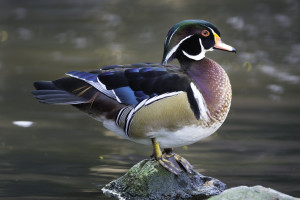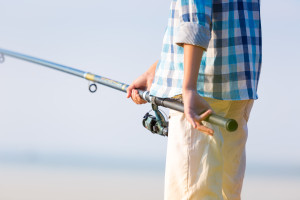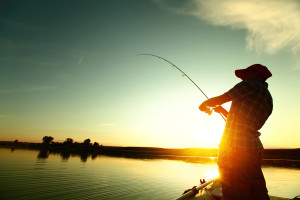 There are numerous species of birds that can be found in the Everglades. At times in the winter, the sight of these birds can look like a scene out of the famous film, “The Birds.” Why? Well, birds migrate down to the Everglades for the winter so hundreds of birds are flying and gathering in the area. For this article, we wanted to focus on one bird so calls the Everglades its home: the wood duck.
There are numerous species of birds that can be found in the Everglades. At times in the winter, the sight of these birds can look like a scene out of the famous film, “The Birds.” Why? Well, birds migrate down to the Everglades for the winter so hundreds of birds are flying and gathering in the area. For this article, we wanted to focus on one bird so calls the Everglades its home: the wood duck.
The wood duck is a North American bird with very colorful features; it has blues, greens, purples mixed with white and black stripes and patches. Because of its coloring, it is known to be a popular birdwatching bird and its sought after by hunters.
In Florida, the wood duck is also known as the “summer duck” or “acorn duck.” It was nearly extinct in the early 1900s, but its numbers were able to increase due the Federal Migratory Bird Treaty Act in 9 1918 that restricted hunting of these birds. Because of this act, the wood ducks is now one of the most abundant waterfowl species on the continent.
Wood ducks have a large head, short neck, long square tail, and a long, slicked-back head crest. The males are more colorful than the females with a red bill and eyes whereas the females are mostly gray and brown with a white ring around their eyes.
Wood ducks’ habitat ranges from Quebec, Canada to south Florida. They migrate up north around March. This type of duck prefers to be around swamps and upland forests near freshwater, which is why the Everglades is an ideal location. They like to be surrounded by shrubs and plants so they have areas where they can find insects, seeds, and fruit.
Wood ducks nest in tree cavities, which keeps them out of harm’s way from foxes, opossums, raccoons, snakes, skunks, and other predators, including other ducks. After nesting, wood ducks molt all their feathers at once and cannot fly again until their new flight feathers emerge in 3 to 4 weeks.
Although the wood duck gets most of its food in shallow waters, it does obtain a lot of food by foraging on the ground in woody swamps and forests, unlike other ducks. Wood ducks eat seeds, fruits, parts of plants, small acorns, some insects, some snails and crawfish.
The wood ducks are one of the only duck species that nest in Florida. Pairing takes place in winter and egg-laying occurs between February and March. They lay around 10 to 15 eggs. After hatching, ducklings will leave the nest the next day. The mother wood duck will stay with her babies until they can fly (around 9 weeks). Due to predators, only 3-4 ducks will survive long enough to fly.
Maximum lifespan of a wood duck is 15 years, but the majority don’t live longer than 3 to 4 years old. To hunt a wood duck or any duck species in Florida, you must have a Florida hunting license and a free Florida Waterfowl permit. These can be obtained from county tax collectors and their subagents, such as hunting supply stores. There are hunting regulations on these ducks including season length and the number of killed ducks allowed per person per day.
If you’re a fan of ducks, you’ll want to visit the Everglades where you’ll see a ton of them! Come explore the Everglades by airboat on a ride with Captain Mitch. Captain Mitch’s Airboat Tours give you a glimpse of the Everglades and a possible glimpse of some wood ducks like no other. To book an airboat ride, click here or call 800-368-0065.
 Did you know that one third of the Everglades is covered by water? It’s true! This makes it an ideal place for visitors and anglers to go fishing. There are many species of fish found in the waterways of the Everglades, but snapper, sea trout, redfish, bass, and bluegill are known to be abundant in this area.
Did you know that one third of the Everglades is covered by water? It’s true! This makes it an ideal place for visitors and anglers to go fishing. There are many species of fish found in the waterways of the Everglades, but snapper, sea trout, redfish, bass, and bluegill are known to be abundant in this area. Love to fish? The Everglades is a great spot to do it, since one-third of this place is covered by water! Throughout the park, there are many acres of shallow water flats, mangrove keys, and channels that make great spots to fish! However, fishing from the shore is limited. In the state of Florida, there are specific freshwater and saltwater licenses and regulations to follow. For important fishing information, click
Love to fish? The Everglades is a great spot to do it, since one-third of this place is covered by water! Throughout the park, there are many acres of shallow water flats, mangrove keys, and channels that make great spots to fish! However, fishing from the shore is limited. In the state of Florida, there are specific freshwater and saltwater licenses and regulations to follow. For important fishing information, click  Did you know you can go fishing in the Everglades? You can! Since one-third of the Everglades is water covered, it makes sense that there are plenty of places where fishing would be ideal! In the Park, anglers have the opportunity to catch a variety of fish, including: snapper, redfish, bass, sea trout, and bluegill. Being a national park and in the state of Florida, people must be aware and abide by local fishing information.
Did you know you can go fishing in the Everglades? You can! Since one-third of the Everglades is water covered, it makes sense that there are plenty of places where fishing would be ideal! In the Park, anglers have the opportunity to catch a variety of fish, including: snapper, redfish, bass, sea trout, and bluegill. Being a national park and in the state of Florida, people must be aware and abide by local fishing information.





